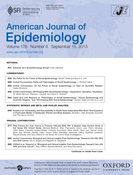-
PDF
- Split View
-
Views
-
Cite
Cite
BongKyoo Choi, Marnie Dobson, Paul A. Landsbergis, Sangbaek Ko, Haiou Yang, Peter Schnall, Dean Baker, RE: “Need for More Individual-Level Meta-Analyses in Social Epidemiology: Example of Job Strain and Coronary Heart Disease”, American Journal of Epidemiology, Volume 178, Issue 6, 15 September 2013, Pages 1007–1008, https://doi.org/10.1093/aje/kwt192
Close - Share Icon Share
Although we read with interest the commentary by Kivimäki and Kawachi (1) on the need for more individual-level meta-analyses in social epidemiology, we do not agree with the authors that the findings in the article by Kivimäki et al. (2) resolve 3 longstanding debates in the literature on 30-year job strain and coronary heart disease (CHD), namely: 1) the relative importance of job strain components (job control and job demands) in relation to CHD; 2) differences in the association between job strain and CHD by age and sex; and 3) differences in the association between job strain and CHD by socioeconomic status (SES). First, of the 13 European cohort data sets that Kivimäki et al. used for the meta-analysis (2), only 3 had been published, whereas the remaining 10 data sets were unpublished. Data from many published cohort studies from European and non-European countries were not included. A recent review by Eller et al. (3) of studies published through February 2009 included 13 articles on cohort studies that contained information on the association between job strain and CHD, and there were at least 17 such studies in a recent review of the published literature through March 2013 that we conducted. A comprehensive meta-analysis based on all existing published and unpublished cohort data could generate better information to address the longstanding issues.
The 13 cohorts included in the Individual-Participant-Data Meta-analysis of Working Populations (IPD-Work) Consortium article (2) also have intrinsic limitations for drawing definitive answers to the longstanding debates: Only 3 of the cohorts were randomly selected from general working populations that had participation rates of more than 50%, and most of the others were recruited from white-collar organizations (4). Workers facing job strain are less likely to participate in occupational health studies than are workers who are not facing job strain (5), and the prevalence of job strain is generally lower in white-collar occupations than in blue-collar occupations (6). Thus, low SES strata and job strain groups are both likely to be underrepresented in the IPD-Work paper, in which job strain was more strongly associated with CHD in higher SES strata than in lower SES strata (hazard ratios = 1.65 vs. 1.24, respectively). Therefore, the debate regarding SES differences in associations cannot be resolved with the limited IPD-Work data. The underrepresentation likely restricts the ranges of job strain and its components (particularly job control (6, 7)), potentially leading to an underestimation of the true associations of job strain and its components with CHD (8). Restriction of range also makes it more difficult to make a strong claim about the relative importance of the job strain components.
Additionally, 4 cohort studies that were not qualified to provide a harmonized job strain measure were included in the IPD-Work paper (2). Job strain was measured with several different instruments with either complete or incomplete scales of job control and psychological job demands across the IPD-Work cohorts. IPD-Work researchers (9) concluded that job strain measured with 1 complete scale (e.g., job control) and 1 incomplete scale (e.g., psychological job demand) could be considered to assess the same construct across the cohorts. However, 4 cohorts (Danish Work Environment Cohort Study, Netherlands Working Conditions Survey, Permanent Onderzoek Leefsituatie, and Still Working) of the 13 in the article by Kivimäki et al. (2) did not meet the criterion (i.e., job strain was measured with 1 incomplete job control scale and 1 incomplete job demand scale) (10). We calculated a higher association between job strain and CHD (when including only the 9 qualifying cohorts, hazard ratio = 1.32; with all 13 cohorts, hazard ratio = 1.23) (10). However, it is largely unknown how the use of unqualified cohorts affected the findings of the meta-analysis (2) on the 3 longstanding issues (e.g., SES differences in associations). Despite some methodological merits (e.g., access to individual data) of an individual-level meta-analysis over a conventional meta-analysis (11, 12), it is not a panacea for all methodological and interpretation issues as noted above.




